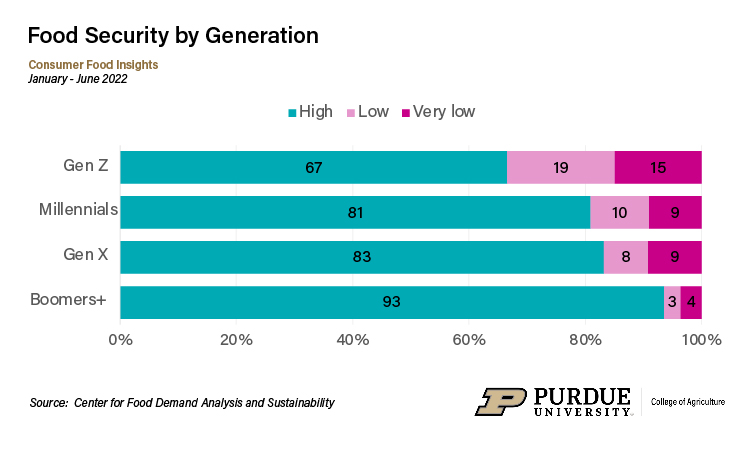The generational divide shows in our food system, too
Gen Z households are struggling more to put food on the table compared to those of Millennials, Gen X and Boomers, according to the Consumer Food Insights Report.
Thirty percent of Gen Z household report seeking groceries from a food pantry, church or other charity in the last 30 days compared to eight percent of Boomer households, it showed.
The survey-based report out of Purdue University’s Center for Food Demand Analysis and Sustainability assesses food security and spending, consumer satisfaction and values, support of agricultural and food policies and trust in information sources.
In addition to the monthly survey, the team analyzed how responses differed between respondents of different age groups. The team studies survey data from January to June of 2022 and divided respondents into the age groups of Gen Z (those born after 1996), Millennials (those born from 1981-1996), Gen X (those born from 1965-1980) and Boomers+ (those born before 1965). The results showed differences in food security, beliefs about their food and food system, shopping habits, policy support and in what information sources they trust.
“Since January, around 30 percent of Gen Z adults have experienced or are experiencing food insecurity compared to around 19 percent of Millennial and Gen Z adults and 7 percent of Boomers,” said Jayson Lusk, the head and Distinguished Professor of Agricultural Economics at Purdue, who leads the center. “Those who are younger tend to have lower incomes, so the results aren't necessarily surprising, but we need to pay attention to it. Food inflation is outpacing salary growth, and it hits those with the lowest incomes the hardest.”
Purdue experts conducted and evaluated the survey, which included 1,200 consumers across the U.S.
Additional key results include:
-
16 percent of all households are food insecure
-
Most consumers are worried about the impacts of the war in Ukraine on food supplies
-
Food demand and happiness continue to be price insensitive
-
Trust in the FDA dropped more than 20 percent from last month
-
A Sustainable Food Purchasing (SFP) Index of 70/100.
 An analysis of food security by age group is part of the Purdue Consumer Food Insights Report, a monthly report identifying trends and changes in consumer food purchases and preferences. (Purdue University image/Courtesy of the Center for Food Demand Analysis and Sustainability)
An analysis of food security by age group is part of the Purdue Consumer Food Insights Report, a monthly report identifying trends and changes in consumer food purchases and preferences. (Purdue University image/Courtesy of the Center for Food Demand Analysis and Sustainability) The survey results show consumers clearly follow current events, Lusk said. Seventy percent of respondents are worried about the Russia-Ukraine war affecting global food supplies, and 58 percent said the war had impacted the price or availability of their food.
The continuing drop in trust of the Food and Drug Administration also correlates with its recent involvement in controversies, he said.
It is interesting that the rapid rise of food prices does not seem to have yet changed how Americans think or feel about their food, as food satisfaction measures remain strong, said Sam Polzin, a food and agriculture survey scientist for the center and co-author of the report.
"Official government estimated show food prices, like gas prices, dramatically rising over the past year, though not quite as sharply as gas," Polzin said. "However, consumers report being extremely dissatisfied with gas affordability, but feeling neither satisfied nor dissatisfied with food affordability. Perhaps this says more about the unique power gas prices have on the American psyche."
The Sustainable Food Purchasing Index offers insight into how sustainability and health relate to consumer behaviors. It is a self-reported assessment of how consumer shopping habits correspond with healthy diets from sustainable food systems. The June score was the highest of the survey to date, but remains broadly consistent, Polzin said. Millennials scored the highest on the environment, social and nutrition indicators; while consumers in the Boomer+ group scored higher on the taste, economic and security indicators.
Lusk further discusses the report in his blog.
The Center for Food Demand Analysis and Sustainability is part of Purdue’s Next Moves in agriculture and food systems, and it aims to use innovative data analysis shared through user-friendly platforms to improve the food system. In addition to the Consumer Food Insights Report, the center offers a portfolio of online dashboards.






